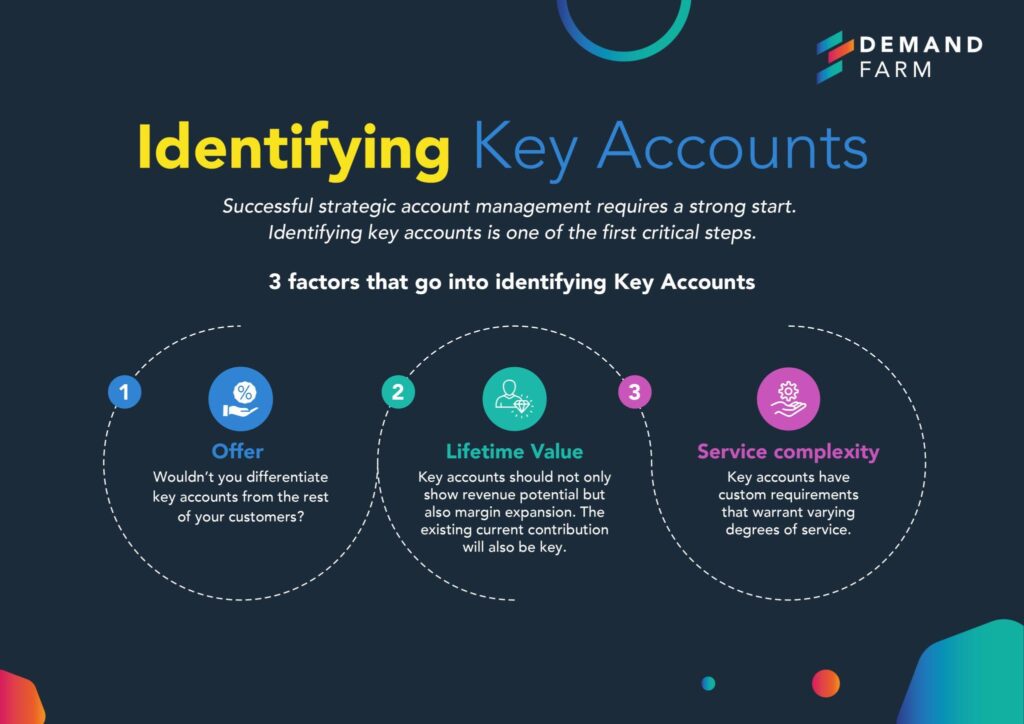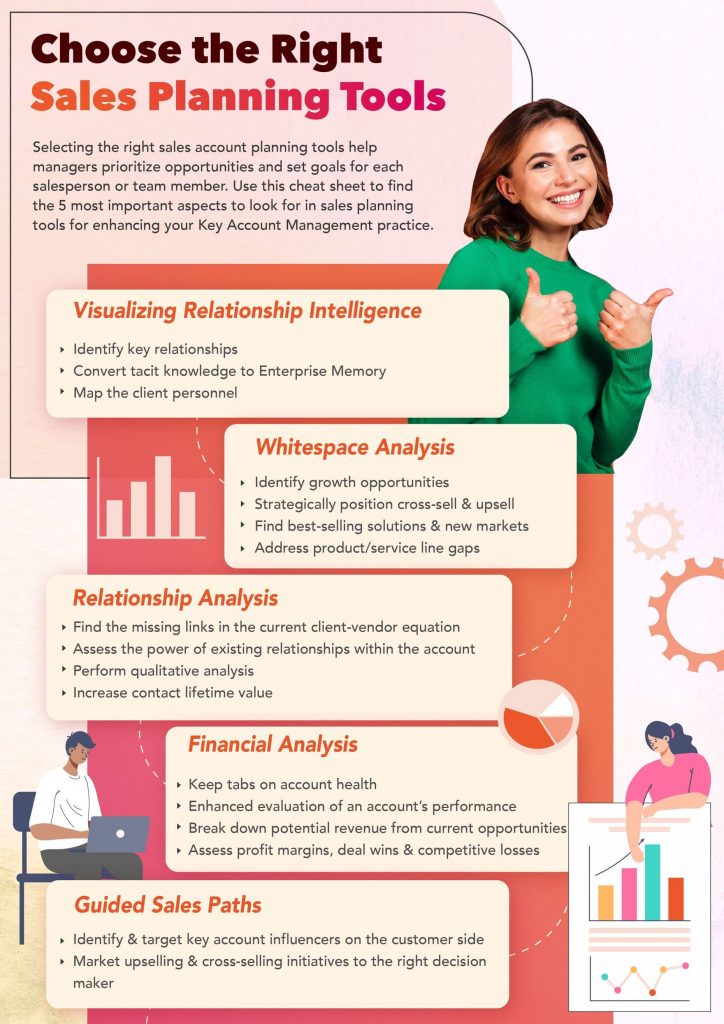In today’s digital-first world, traditional Key Account Management (KAM) strategies are no longer enough to keep up with the ever-changing demands of customers. The B2B sector is evolving at an unprecedented rate, and it’s critical that companies adapt to this new landscape to stay ahead of the game.
Research is increasingly showing that companies implementing a digital Key Account Management strategy outperform their peers. This means, developing a comprehensive digital Key Account Management strategy is no longer a ‘nice-to-have’ but a ‘must-have’ for any B2B company looking to drive revenue growth, strengthen relationships with their most valuable customers and improve customer satisfaction.
So, what does a successful digital Key Account Management strategy look like? It starts with understanding the unique needs of your key accounts and developing a customized approach that leverages the latest digital tools and techniques to drive engagement and revenue growth. This includes the whole gamut – from leveraging data analytics to identifying customer needs and preferences to automating routine tasks to allow your sales team to focus on revenue-generating activities.
Digital Account Management Masterclass
This comprehensive guide is an excellent resource to help you develop a comprehensive digital Key Account Management strategy. It will take you through how you can define your digital Key Account Management objectives, identify your key accounts and utilize the latest digital tools to drive customer engagement and improve profitability.
Watch Now: Insights on Digital Key Account Management by James Manno, VP of Sales Enterprise @ Qualtrics
Understanding Your Key Accounts

If you’re in business, understanding the importance of your key accounts is crucial. Your key accounts typically generate a significant portion of your revenue. They can help sustain your business over the long term. But, managing key accounts in the digital era required a unique set of skills and strategies
By following these steps, you can develop a successful digital Key Account Management strategy:
Understanding your key accounts is the first step in developing a successful digital Key Account Management strategy. It involves identifying who your key accounts are, understanding their business goals and objectives and developing a customer-centric approach.
To identify your key accounts, you’ll need to analyze your sales data to determine which customers generate the most revenue for your business. Your key accounts may also include some customers that have been part of your journey for a long time. Or those that you’ve identified as having immense growth potential.
Once you have a list of your top customers, you can then start to examine their specific needs and goals. This could involve conducting customer surveys, reviewing customer feedback, or engaging in one-on-one conversations with key decision-makers at these accounts.
Once you have a better understanding of your key accounts, you can begin to develop a customer-centric approach. This involves tailoring your sales and marketing strategies to meet the specific needs and goals of each account. For example, if you have a key account that’s focused on sustainability, you might want to highlight the eco-friendly nature of your offerings in your sales and marketing material.
Ultimately, the key to developing a successful digital Key Account Management strategy is to put your customers at the center of everything you do. By focusing on their needs and business objectives you can develop more effective sales and marketing strategies. You will also be able to build stronger relationships with your key accounts and create sustainable revenue streams for your business.
Follow & Listen to Insights from The Shift Podcast by DemandFarm on Digital Key Account Management
Developing a Digital Key Account Management Strategy
Developing a digital Key Account Management strategy can be a complex process, but it’s essential for success in the B2B sector. To get started, it’s important to consider a few key factors.
First, it’s important to understand the role of data and technology in your strategy. Using the right tools and technologies makes it easier for you to track customer interactions, identify buying patterns and tailor our approach to each key account. This may involve investing in customer relationship management (CRM) software, data analytics tools, or other technologies to help you gather and analyze customer data.
Once you have a clear understanding of the role of data and technology it’s important to set specific goals and key performance indicators (KPIs) for your digital Key Account Management strategy. Your KPIs may include increasing customer engagement, improving customer satisfaction, or driving more revenue from key accounts.
To achieve these goals, you’ll need to select the right digital tools and technologies to support your strategy. This might include tools for account-based marketing, social media management, email marketing or other digital marketing channels. It’s important to select tools that align with your goals and the needs of your key accounts.
For instance, imagine you’re a manufacturer of industrial equipment, and you have a key account that’s a major player in the oil and gas industry. Here, you might want to focus your digital Key Account Management strategy on account-based marketing. The tools that would work best for you include LinkedIn advertising or content marketing to reach decision-makers in the oil and gas company. You could showcase how your industrial equipment can improve the operations and profitability of your key account.
Additionally, your digital Key Account Management Strategy might involve implementing a customer relationship management (CRM) system. This CRM system could be used to track interactions with the key account, manage the sales pipeline and ensure that everyone involved with the account has visibility into the account’s history and current status. This helps coordinate and streamline the efforts of sales and account management. It also helps identify opportunities for cross-selling and upselling.
Guide: Cross-selling & Up-selling Explained
While selecting digital tools and technologies to support your digital Key Account Management strategy, it’s important to consider factors like scalability, ease of use, and integration with existing systems.
For example, if you’re already using a particular CRM or marketing automation platform, it makes sense to look for digital Key Account Management tools that integrate with those platforms. This can streamline workflows and ensure that data is consistent and up-to-date across all systems.
Ebook: 7 Must-Have Requirements for a Good Digital Account Planning Solution
Another important consideration is the level of customization and personalization that different tools offer. For instance, some account-based marketing tools may allow you to create highly personalized ads or High-performing landing pages tailored to specific decision-makers with the key account. Others may offer more limited customization options. The final decision depends on your specific business goals and what your customers are looking for to grow their businesses.
Examples of Digital Key Account Management Tools

When it comes to digital KAM tools, there is no one-size-fits-all option. The right tool for your business will depend on your business needs and goals. A true digital Key Account Management solution should integrate with the current platforms and apps that you currently work with in your business. Your digital Key Account Management program should form a connected app ecosystem that can bring together insights from various tools and platforms. Eventually, all your tools should work together to give you the most relevant information and contextual insights to help you build a better, more effective selling process.
Learn More: A Checklist for an Ideal Digital Account Planning Tool
Here are a few digital Key Account Management tools that can help you manage your key accounts:
- Customer Relationship Management software: A foundational tool for managing customer data and interactions. It can help you track customer interactions, manage sales pipelines, and automate customer communication.
- Account-based marketing (ABM) software: It helps you target specific accounts with personalized marketing campaigns. It can help you build relationships with key accounts and increase customer loyalty.
- Sales enablement software: This software provides sales teams with the tools they need to be more effective. It can help create and distribute sales collateral, track customer engagement and provide sales coaching and training.
- Business Intelligence (BI) software: It helps with analyzing customer data and provides insights into customer behavior. It can help identify trends and patterns in customer data and which can strengthen your digital KAM strategy.
- Collaboration tools: Apps like Slack, Microsoft Teams, Zoom etc. that can facilitate collaboration and improve communication with your key accounts. These have become popular tools of choice to facilitate meetings, share information and build stronger relationships with your key accounts.
Building Strong Relationships with Key Accounts in a Digital Environment
In a digital environment, building and maintaining trust and credibility with key accounts can be challenging. But it’s crucial for long-term success. One way to establish trust is by providing personalized support and service to your key accounts. This can be done by leveraging tools such as chatbots or personalised email campaigns to provide quick and efficient support.
Another key element in building strong relationships is regular and effective communication. With the rise in digital channels, it’s easier than ever to stay in touch with your key accounts. However, it’s important to ensure that your communication is personalized and relevant to their needs.
Best practices for communicating with key accounts in a digital environment include:
- Regularly scheduled check-ins: to provide updates, answer questions, and discuss their needs.
- Personalized messaging: to show that you understand their business and their needs.
- Use of multiple channels: to communicate with your key accounts. Use a mix of email, phone, video conferencing and chat to stay in touch.
- Share relevant content: such as industry news, research reports, or case studies that showcase how your products or services can help them achieve their goals.
- Provide value-added services: like training sessions, webinars, or consulting services to help your key accounts get the most out of your products and services.
These best practices will help you build strong relationships with your key accounts and help your company to achieve long-term success in the digital environment.
Growing Key Accounts in a Digital Environment
Digital Key Account Management is not just about maintaining existing relationships but also about identifying growth opportunities. Here’s how you can grow key accounts in a digital environment.
Identify opportunities for growth through digital channels:
To identify opportunities for growth through digital channels, it’s important to have a deep understanding of your key account’s business and the challenges they face. Use data and analytics to uncover potential areas of growth and identify opportunities for cross-selling and upselling.
For example, if your key account has recently expanded its business into a new market, you could identify products or services that would be useful in that market and suggest them as potential upsell opportunities.
Upselling and Cross-Selling Strategies that Work in a Digital Environment:
- Personalized product recommendations: Using data and analytics you are better placed to understand the business goals and associated needs of your key accounts. This helps you personalize your product recommendations. For example, if your key account frequently purchases a certain type of product, you could suggest related products or upgrades.
- Bundling: Offer your key accounts a bundle of products or services at discounted rates. This can be an effective way to encourage cross-selling and improve the overall value of the relationship.
- Loyalty programs: Creating loyalty programs that reward your key accounts for their continued business can be an effective strategy to encourage cross-selling. Key accounts that form part of this loyalty program could be offered first information or trials of new offerings. This would incentivize them to continue purchasing from you.
Best Practices for Building Customer Loyalty and Advocacy through Digital Means:
Building customer loyalty and advocacy is critical to long-term success in digital Key Account Management. These best practices will help you build strong relationships with your key accounts in a digital environment. They will also help identify opportunities for growth to help you achieve your business goals.
- Provide excellent customer service: In a digital environment, providing excellent customer service is more important than ever. Make sure your key accounts have access to a dedicated support team and ensure that any issues are resolved quickly and effectively.
- Regular communication: Regular communication is key to building strong relationships, especially in the digital world in which we operate. Make sure to check in with your key accounts often. Email, chat, and video conferencing are a few of the digital channels you can use to stay connected.
- Thought leadership content: Creating thought leadership content that provides value to your key accounts can be a great way to build customer loyalty and advocacy. This could include industry reports, white papers, or webinars that showcase your expertise and provide insights relevant to your key accounts’ businesses.
Measuring Success in Digital Key Account Management:
One of the biggest benefits of digital Key Account Management is the ability to track and measure your success with real-time data. This allows you to make continually improve your strategy through informed decision-making.
Consider these key metrics when measuring the success of your digital Key Account Management program:
- Revenue: This is the ultimate measure of success for any sales strategy. You should track revenue growth and revenue from key accounts to ensure that your digital strategy is driving the results you seek.
- Customer retention: Repeat business is a strong indicator of customer satisfaction and loyalty. Tracking customer retention rates can help you identify areas where you need to improve.
- Engagement: Tracking engagement metrics like email open rates, website traffic, and social media interactions can help you understand how your key accounts are interacting with your brand.
- Conversion rates: Measuring the conversion rates of your digital campaigns and activities can help you identify which tactics are most effective in driving sales.
- Customer satisfaction: Tracking customer satisfaction through surveys and other feedback mechanisms can help you identify areas for improvement in your customer service and support.
Once you’ve identified the key metrics of importance for your business, use the data to make business decisions.
For example, if you notice that engagement rates are low for a particular key account, you may need to adjust your communication strategy to better meet their needs. Or if a particular campaign has high conversion rates, you may want to invest more resources in that area.
By making decisions supported by data you can drive continuous improvement in your digital Key Account Management program.
Key Account Management Glossary: Crucial Account Management Terms Explained
Unlocking the Potential of Key Account Management with DemandFarm
DemandFarm is a leading provider of digital Key Account Management solutions. They take an expert, yet consultative, approach to help companies develop and implement successful Key Account Management programs.
Learn More: Key Takeaways for a Successful Key Account Management Transformation Journey
Working with DemandFarm allows companies to strike the perfect balance between best practices and non-negotiables. They work with highly modular tools that allow for a progressive and phased approach to Key Account Management transformation. And all of this is done with the customer as a priority. Additionally, all their products allow customization across industries, sizes and maturity of accounts. They thus ensure that the KAM approach is tailored to the specific needs of each organization.
Conclusion
Digital Key Account Management is no longer just a “nice-to-have” for B2B companies. It’s an essential part of staying competitive in today’s market. By understanding your key accounts, developing a digital Key Account Management strategy, building strong relationships, and measuring success through key metrics, you can create a customer-centric approach that improves business profitability and builds long-term customer loyalty.
But it’s not enough to simply check off all these boxes and call it a day! To truly succeed in digital Key Account Management, you need to stay agile, informed and focused on your customers’ needs and goals. That means staying up to date on the latest trends and technologies. You also need to adapt to changing customer preferences, and continually iterate and improve your approach.
Ultimately, digital Key Account Management is about putting your customers first and providing the best possible solution, service and support. By doing all of this, you can build relationships that last a lifetime, and create continuous revenue streams for your business.



